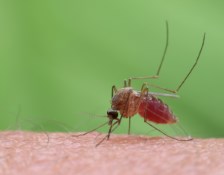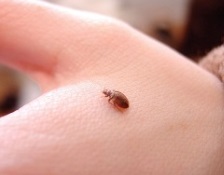
Reducing Vectorborne Disease Transmission
Vectors are organisms that transmit pathogens and parasites from one infected person (or animal) to another, causing serious diseases in human populations.
Mosquito-borne diseases that may occur locally in Ohio include: Eastern equine encephalitis virus (EEEV), LaCrosse virus (LACV), St. Louis encephalitis virus (SLEV), and West Nile virus (WNV). Mosquito-borne diseases that may be imported into Ohio (travel-acquired) include: Chikungunya virus (CHIKV), Dengue, Japanese encephalitis (JE), Malaria, Yellow fever, and Zika.

Mosquito Control Program
LCHD practices an integrated pest management (IPM) approach to mosquito control. This includes trapping for adults, dipping for larvae, treating standing water with larvicide, draining breeding sites when possible, and spraying to kill adults when needed.
Avoid being bitten by mosquitoes; clothing will help protect you from mosquito bites. When possible, wear long sleeves, long pants and socks in addition to repellent when outdoors. Repel mosquitoes when going outdoors during mosquito season by using repellents that contain an EPA-registered active ingredient such as DEET or picaridin. Follow the directions on the label. Be aware of peak mosquito hours. Mosquitoes are most active and biting during the early morning and late evening hours. If outdoors at dawn or dusk, take extra care to use repellent and wear protective clothing. Keep window and door screens closed and in good repair to keep mosquitoes out of your house. Mosquitoes rest in tall weeds. Keep weeds cut short to help deter mosquitoes. Drain water where mosquitoes grow. Mosquitoes can grow in containers that hold water for more than a week such as pop cans, buckets, bottles and discarded tires. Containers filled with water should be emptied at least once a week. Change the water in birdbaths every week. Keep rain gutters clean. Fix outdoor leaking faucets. Clean ditches so water can flow. Fill holes that hold water with gravel or dirt.
Pesticides used by LCHD to control Mosquitoes: Altosid larvicide briquettes - Label/SDS and AquaAnvil - Product Label /SDS

Tick-Borne Diseases
Diseases spread by ticks are an increasing concern in Ohio and are being reported to the Ohio Department of Health more frequently in the past decade, with Lyme disease and Rocky Mountain spotted fever (RMSF) being the most common. Other tickborne diseases such as anaplasmosis, babesiosis and ehrlichiosis are also on the rise. Though rare, diseases such as tularemia, southern tick-associated rash illness (STARI) and Powassan virus may also be carried by Ohio ticks.
There are about a dozen species of ticks that have been identified in Ohio. However, most species are associated with wild animals and are rarely encountered by people.Three species, the American dog tick, the blacklegged tick and the lone star tick, are among the most likely ticks to be encountered by people or pets. All three of these species are of significant public health importance and are responsible for nearly all reported tickborne diseases. Find out more about these types of ticks here.
The best way to prevent tickborne diseases is to prevent tick bites. In Ohio, tickborne illnesses are most often transmitted between early spring and late fall since ticks are most active during warm months. Take action to decrease your risk of infection: protect against tick bites, check for ticks, remove ticks as soon as you can, and watch for symptoms.
Lyme disease is caused by an infection with a bacterium called Borrelia burgdorferi. In Ohio, B. burgdorferi is transmitted to humans through the bite of an infected blacklegged tick, Ixodes scapularis. Lyme disease cases are increasing in Ohio as the range of blacklegged tick populations continues to expand in the state and encounters with this tick occur more frequently, particularly in the forest habitats preferred by this tick.

Bed Bugs
Bed bugs are not a disease vector, they are however a public health pest. While bed bugs have not been shown to transmit disease, they do cause a variety of negative physical health, mental health and economic consequences.
Bed bugs are small insects that feed on human blood. They are usually active at night when people are sleeping. Adult bed bugs have flat rusty-red-colored oval bodies. Adult bed bugs are about the size of an apple seed, they are big enough to be easily seen, but often hide in cracks in furniture, floors or walls. When bed bugs feed, their bodies swell and become brighter red. They can live for several months without feeding on a host.
Most bed bug bites are initially painless, but later turn into large, itchy skin welts. These welts do not have a red spot in the center as do the bites from fleas.
Bed Bug Q&A:
ARE BED BUGS DANGEROUS? Although bed bugs and their bites are a nuisance, they are not known to spread diseases.
HOW DOES A HOME BECOME INFESTED WITH BED BUGS? In most cases, people carry bed bugs into their homes unknowingly in infested luggage, furniture, bedding or clothing. Bed bugs may also travel between apartments through small crevices and cracks in walls and floors.
HOW DO I KNOW IF MY HOME IS INFESTED WITH BED BUGS? You may notice itchy skin welts. You may also see the bed bugs themselves, small bloodstains from crushed insects, or dark spots from their droppings. It is often hard to find them because they hide in or near beds, other furniture and in cracks.
SHOULD I USE A PEST CONTROL COMPANY? The LCHD recommends homeowners hire pest control companies licensed by the Ohio Department of Agriculture to control bed bugs.
WHAT IF I FIND BED BUGS IN MY HOTEL ROOM? Hotels in Ohio are regulated by the State Fire Marshal, the number to contact them with a complaint is 888-276-0303 or email them at websfm@com.state.oh.us
University of Minnesota Bed Bug Information
Central Ohio Bed Bug Task Force
Preventing and Getting Rid of Bed Bugs Safely
